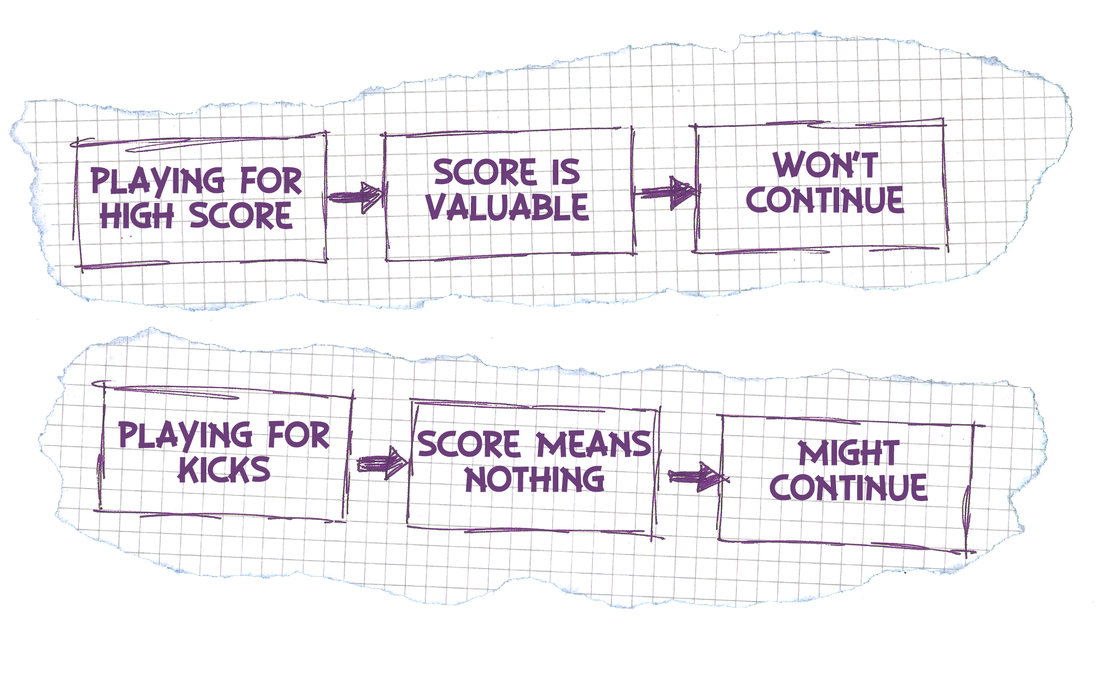|
21/12/2014 1 Comment Aubergine - Shmups: From Arcade to PCWARNING: The word "shmup" will be repeated to the point of nonsense in this post. I'll use "shooter" here and there for the sake of variety but it really don't break it up enough. I'm sorry. I'm so sorry. Shmups, or "Shoot 'Em Ups" rather, have a long and rich history that can be traced back to the earliest days of video games. Whilst Space War (1962) is often taken to be the first shmup, it's Space Invaders (1978) that really lead to the birth of the genre we recognize today with all of its recognizable conventions and sub-genres. It was, simultaneously, largely responsible for the Golden Age of gaming and the rise of the video arcade. And indeed, shmups of every sort, be they fixed, on rails, multi-directional or scrolling, have a deep-rooted connection to the arcades. And to examine the genre you are required to examine the place they were all born and raised and the effects the environment had on the product. I mean look at these beautiful vertical displays! This is the kind of feature that was only practical (or possible, even) in arcades for a very long time. But why am I telling you all of this? Well, because the classic scrolling shooters of the 90's (developed by the likes of CAVE, Raizing and Psikyo) are the direct inspiration behind Aubergine. The thing is that whilst the popularity and success of arcades fell into decline and video games of practically every sort moved to home consoles and personal computers, shmups were mostly left behind in the arcades. And unfortunately this long history with the arcades has had a real impact on systems and mechanics that now seem an inherent part of the genre, and many of these aspects don't work so well outside of the arcade. One good example of this is the credits/continue system which is seen in almost every arcade game. Usually inserting coins into the arcade machine grants you a credit and a credit equals one shot at tackling the game. Example: Batsugun (1993) is a bona fide classic! One credit gives you three lives; three chances to see the game through to the end. When all lives are lost the game presents the continue screen. This gives the player a short amount of time to decide whether or not they want to continue (or if they can even afford it). This created this cool situation wherein continues were tied to something with a real sense of value, meaning that every death had a real impact on your playing experience. Sure, someone could die on every screen, at every opportunity and still see the game through to the end but this would be very expensive. Now, in my experience shmups on PC and home consoles never really manage to capture that same sense of value that the arcade credit system has. And that makes sense, right? I mean, it'd be really dumb if you had to carry out a micro-transaction every time you died in a game you were playing on your phone or something (seething satire). Instead most will just give you an infinite number of continues, sometimes they'll give you a set finite number of continues, and some just drop continues altogether. And I guess that's fine, but none of these options carry the value or weight of the arcade system, and in the case of the infinite continues it actually manages to cheapen the experience. I've seen some games that opt for the infinite continues option that try and make continuing more of a non-option by resetting the player's score to 0 upon continuing. This may seemingly provide a big enough con to prevent people from continuing too much, and it certainly does stop it being a viable option in high level play (score runs) but for those are who just blasting through the game, trying to reach the end? It has NO impact. This essentially just splits players into two camps: The problem here is that the score only has a value within score runs and the people doing that ain't ever going to continue if it's going to damage their score. It provides a con to one type of player but not the other. Not to mention that the penalty is so severe that no respectable player aiming for a high score would even consider continue. The result is a system that just doesn't work. Now, I've heard it said in shmup development circles that you should always keep in mind that the people playing your shmup will almost certainly be shmup fanatics; guys and gals who've spent hours upon hours remembering enemy bullet patterns in DoDonPachi (1997) and the like. If that is indeed your audience then it certainly makes sense to keep them in mind when you're approaching the mechanics and level of difficulty present in your game. However, the only people guaranteed to actually play Aubergine are my friends and family; none of whom have DoDonPachi bullet patterns stored in their memory (in fact, they probably have no idea what DoDonPachi is). So who am I designing this game for? The hardcore fans of the genre or the newbies? Well why not both? Aubergine was born out of my desire to construct MY perfect shmup, combining all of the best elements from my favorite shmups into one mega-shmup. And I think part of that is trying to capture what it is that I love about the genre, for others to see. So in this credit/continue problem I see an opportunity to overlap the interests of the shmup fanatic and the shmup layman. And it's an idea so simple that I'm convinced that someone must have already implemented it. *drum roll* Your score IS your credits. The idea here is that since your continues aren't attached to a real life, finite valuable resource (money) they can just be attached to a virtual, finite valuable resource. So let's say a continue costs 2000 points. That means that any player with 2000 points or higher will be presented with an opportunity to continue upon losing all of her lives. If a player doesn't have enough points then they can't continue. Simple. The real benefit here isn't just the weight this lends proceedings but how it will (hopefully) affect players. Remember that diagram from before? The aim is to replace that with this: Okay, okay, I'm pretty sure that the folks gunning for high scores still won't be interested in continuing but you never know! The real aim here is to make the score valuable to every kind of player. In this way I hope to encourage everyone to pay attention to their score and think of ways to increase it.
Will it work? I have no idea, but it's easy enough to implement so there's no harm in trying.
1 Comment
Leave a Reply. |
Me
3D Artist, Game Dev and Teacher based in Liverpool, UK Archives
February 2018
|







 RSS Feed
RSS Feed